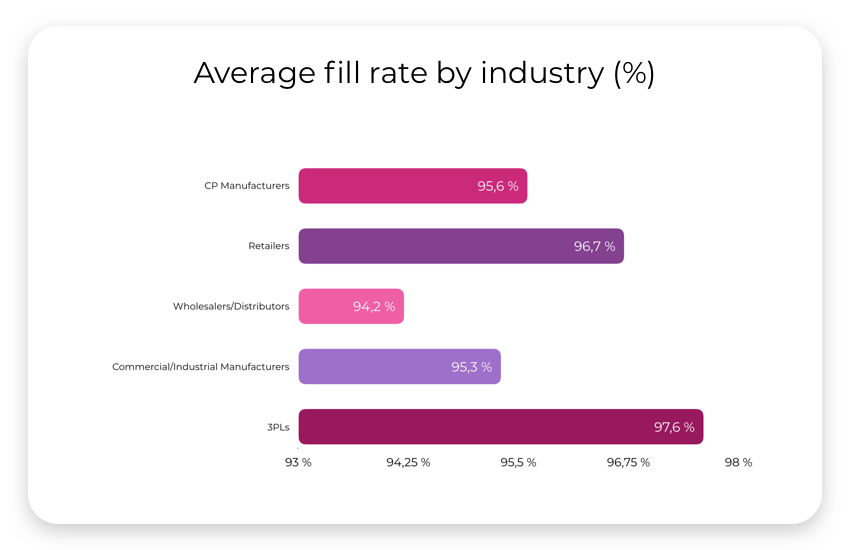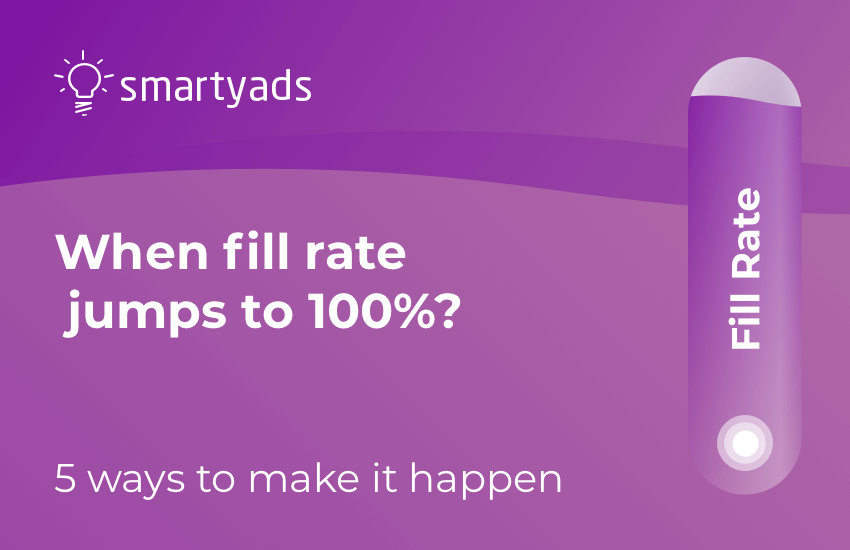Let's say that you are a publisher and have 10,000 ad slots available on your website. If your ad network fill rate is only 50%, that means you are only using 5,000 of those ad slots to generate revenue. If each ad is priced at $1, and you receive 1,000 clicks on those ads, you would generate $5,000 in revenue.
However, if your fill rate was 100%, you would generate $10,000 in revenue from those same 10,000 ad slots. This shows how important it is to have a high ad network fill rate in order to maximize your website's revenue potential. So, in this article, we will talk about how to increase fill rate to its max.

What is Ad Fill Rate?
Ad fill rate is a digital advertising metric that measures the percentage of ad requests that are successfully filled by an ad network or platform. To put it simply, it reflects how effectively an ad network is able to monetize the available ad inventory.
Factors Influencing Ad Fill Rate
Several factors influence the ad fill rate. You can use it to optimize fill rate ads to maximize revenue potential.
Demand-Side Factors: The ad fill rate is influenced by advertiser demand. Higher demand means higher fill rates and more revenue for publishers.
Ad Quality: The quality and relevance of the ads served can impact fill rates. Advertisers are more likely to bid on ad placements that align with their target audience and campaign objectives, resulting in higher fill rates.
Ad Placement and Format: Advertisers are more likely to bid on ad placements that are prominently displayed and have an engaging format, which, in turn, increases the possibility of the ad being filled. Therefore, it is crucial to optimize the ad placement and format to maximize the revenue potential of the website.
Geographic and Demographic Factors: The geographic location and demographic profile of the audience targeted by the publisher can influence ad fill rates. Advertisers may prioritize certain regions or audience segments, affecting the availability of ads for specific inventory.
How to Calculate Ads Fill Rate Formula?
What is fill rate in advertising? Here is the simplest fill rate definition:
Ad network fill rate is the number of displayed ads (a percentage of the total number of ad requests) that was able to satisfy the requests.
Here is an equally simple fill rate formula for calculating your ad fill rates using the calculator:
Fill rate = # of Ads Served/ # of Ads Requested x 100%
If the number of ads requested on the network is 5M and 2.5M is the number of ads served, then your fill rate = 2.5M/5M x 100% = 50%.
With a 50% fill rate, you use only half of your available inventory. To support your revenue, you need higher fill rates and also higher CPM (cost per one thousand impressions). So it doesn’t matter whether you get 5M ad requests of 1$ CPM and 50% fill rate or 2$ CPM and 25% fill rate. However, these metrics are not interrelated, and nothing prevents you from increasing your fill rate regardless of your CPM value.
Why Your Fill Rate Falls Short of 100%
According to the Tompkins Supply Chain Consortium report, the leading publishers achieve a 98% fill rate, when the average is 94.7%. The fill rate will also depend on the industry, thus for the Wholesalers/Distributors it’s averaging at 94.2%, CP and Industrial Manufacturers reach up to 95.3% and 95.6%.

Let’s discuss the possible reasons why your fill rates may drop low. This shortfall can be attributed to various factors, ranging from technical glitches to market dynamics. Let's delve into some common reasons why your fill rate isn't hitting the coveted 100% mark and explore potential solutions.
1. Technical Errors
Technical glitches such as ad serving errors, misconfigured ad tags, or issues with ad rendering can hinder the fulfillment of ad requests, leading to a lower fill rate. These errors may occur due to server downtime, network latency, or discrepancies in ad serving platforms.
Solution: Regular monitoring of ad serving systems, proactive troubleshooting, and implementing robust error handling mechanisms can help mitigate technical errors and improve fill rates.
2. Lack of Demand
The digital advertising industry is a highly competitive space where businesses vie for a limited pool of ad inventory. In times of reduced demand for ad space, such as during off-peak seasons or economic downturns, the number of ads served and the fill rates may decrease. Advertisers tend to cut down on their ad spending during such periods, which can have a direct impact on the fill rates of the available ad inventory.
Solution: One effective strategy to improve fill rates and reduce the impact of fluctuating demand is to diversify demand sources. This can be achieved by partnering with many ad networks, exploring fill rate programmatic advertising options, and actively seeking out new advertisers. By doing so, you can ensure a steady flow of ad impressions and increase your chances of maximizing revenue.
3. Compatibility Issues
Compatibility issues between ad formats, devices, or browsers can prevent ads from being served to certain segments of the audience, leading to a reduced fill rate. Advertisers may specify targeting criteria or ad specifications that limit the compatibility of their creatives with specific platforms or environments.
Solution: Ensuring compatibility across a wide range of devices, browsers, and ad formats, conducting thorough testing before deploying ads, and providing alternative ad options for incompatible environments can help improve fill rates.
4. Latency
Slow-loading ad creatives, inefficient ad delivery mechanisms, or network congestion can cause high latency in ad serving, leading to missed opportunities and lower fill rates.
Solution: Optimizing ad delivery infrastructure, compressing ad creatives to reduce file size, leveraging content delivery networks (CDNs) for faster content delivery, and implementing lazy loading techniques can help reduce latency and improve fill rates.
5. Ad Blocking
The widespread adoption of ad-blocking software by users presents a significant challenge for publishers, as it directly impacts the availability of ad inventory and reduces fill rates. Ad blockers prevent ads from being served or displayed to users who have installed them, resulting in missed revenue opportunities.
Solution: Educating users about the value exchange of ad-supported content, implementing anti-ad-blocking measures such as ad reinsertion technologies or paywall strategies, and offering alternative revenue streams such as subscriptions or sponsored content can help mitigate the impact of ad blocking on fill rates.
Obviously, some of these factors are out of your control; still, you can utilize 5 following tips to maximize your fill rate.

5 Tips to Maximize Your Fill Rate in Advertising
Ad Fill Rate Improvement Tip #1: Serve Ads of a Universal Size
The most popular ad sizes are a large rectangle (336*280) and medium rectangle (300*250): they bring over half of all impressions. However, it’s better to set a flexible ad size in the ad placement, if you want to increase your fill rate and if it’s not critical for your website.
Removing the restriction on size, you heat up competition between advertisers. The number of ads bidding for the inventory slot increases so you get the better chance to close the deal quickly.
Ad Fill Rate Improvement Tip #2: Match Your Website to the Ad Network
Different ad networks provide different geo-targeting options. That’s why it’s important to find the right fit — if you target audience worldwide the ad network should have a global reach, not local. Otherwise, you won’t be able to target the demographics you need and inventory fill rate will decrease.
So, for instance, if you target the user pool from Brazil, look for ad networks that provide a continuous flow of campaigns targeted at Brazil or worldwide. In case you operate mostly on the Asian market, partner with a network that is focused on Asian demographics, etc.
Ad Fill Rate Improvement Tip #3: Try Different Ad Networks or Ad Exchange
Test multiple ad networks to reveal which ones yield the best results for your website. It’s also possible to collaborate with several networks at a time to ensure a 100% fill rate of each inventory slot.
A better option is to join an ad exchange. Ad exchanges operate similarly to ad networks, but they remove an intermediary in real-time bidding and give publishers more control over conditions determining for the ad placement.
An ad exchange features per impression buy & sell when an ad network works as a bulk trading system. This gives you an opportunity to fill unsold remnants and reach a fill rate close to 100%. For example, SmartyAds ad exchange is based on AI algorithms that ensure an unlimited demand for every impression you serve.
Ad Fill Rate Improvement Tip #4: Challenge Ad Blocking
According to the stats, 11% of internet users worldwide block ads on the web. This number grows by nearly 30% year-by-year making ad blockers a major threat for publishers’ revenue.
The catch is, your inventory fill rate may be displayed as 100%, but its real value will not exceed 89% if the above-mentioned 11% of visitors decide to block ads.
But there are a number of ways to bypass adblock. First of all, you can ask your visitors to whitelist your website. The second method is to use advanced interactive ad formats that easily bypass the blockers, such as playable or rewarded ads on mobiles.
Ad Fill Rate Improvement Tip #5: Embrace the Power of Header Bidding
Not all ad networks offer a 100% fill. However, those with a header bidding technology guarantee full sold out. Header bidding involves a header, an HTML element placed on a publisher’s website. When you have a visitor, the system sends a code to the header, so it automatically sends ad requests to DSPs and ad exchanges.
The average selling process resembles a waterfall: if nobody responds to the first requests, it runs further until somebody finally buys an impression. The header-bidding technology allows taking part in an auction for all advertisers simultaneously that means greater demand and possibility to close the deal with the highest bid offered.
SmartyAds header bidding solution not only improves your fill rate but increases your overall revenue offering your slots to multiple advertisers. Leveraging header bidding, you enhance the competition and select the best bid for each impression.
Sign up for a SmartyAds SSP to get all the necessary tools for improving your fill rate advertising.





